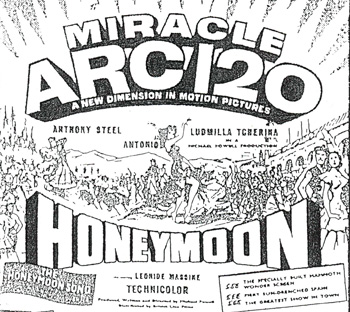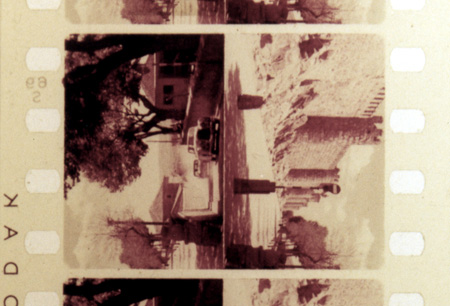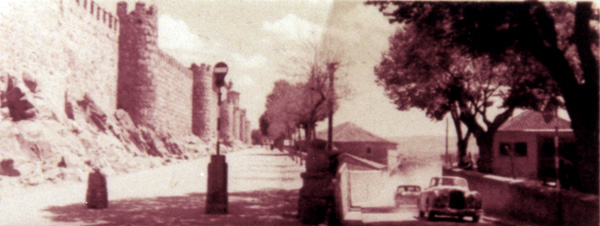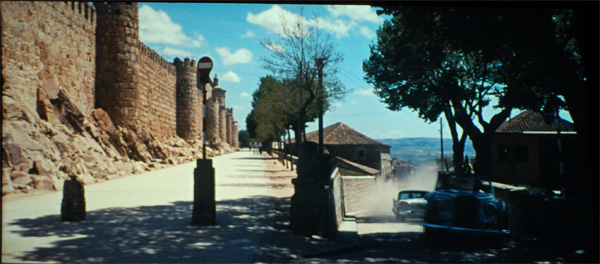Restoration & New Print of "Honeymoon" |
Read more
at in70mm.com The 70mm Newsletter |
| Written by: Charles Doble | Date: 15.05.2008 |
 Mr.
Charles Doble, "Honeymoon"'s restorer, in Bradford, March 2008. Image by
Thomas Hauerslev Mr.
Charles Doble, "Honeymoon"'s restorer, in Bradford, March 2008. Image by
Thomas Hauerslev"Honeymoon" is a film which has matured. A film which is only being appreciated some 40 years after it was originally made and for reasons completely unforeseen by its creator, our unsurpassed British director Michael Powell. Often dismissed as "a Spanish travelogue with frenetic music and dancing" such words completely fail to understand or appreciate this film. The storyline is best summed up in this release, published at the time in 1959: "Ludmila Tcherina and Anthony Steel are on a fabulous honeymoon in sunny Spain. They are rich. They are happy. And then they meet the fiery Spanish dancer Antonio... When Antonio discovers the bride is a prima ballerina who has given up her career for marriage, he refuses to rest until he has persuaded her to dance again - as his partner. Wherever they drive in their gleaming silver convertible, they run into Antonio. On the road outside Santiago; in a fashionable bar in Madrid; at the caves of Grenada. Antonio conducts a captivating campaign. He persuades her to dance with him in his studio. He tempts her with his dancing feet; he lures her on with his mischievous eyes. He breathes into her ear that only she can dance the leading role in his latest production. He ignores the jealous husband. When the three meet in Madrid for the last time Antonio has apparently called off his campaign. Everything it seems, will be back to normal. The honeymooners are free to continue their world cruise. But there's still a twinkle in Antonio's eyes. For he is about to go with his dance company...on a world tour!" |
More
in 70mm reading: Technirama ARC 120 To Split or not to Split ... That is the Hollywood Question! Widescreen Weekend 2008 Internet link: "Honeymoon" restoration web site |
 Poster
from Belgium. Note Technirama logo lower left corner Poster
from Belgium. Note Technirama logo lower left cornerAs with all of Michael Powell's films, these few sentences belie what he is saying to us on a deeper and more surreal level. The film recounts experiences that are common to many of us. The emotional love and attraction which we, as participants, are often helpless to control and which time and circumstances cannot dim. On the other hand, there is love that brings two people together and yet which quickly withers into a mutual and stoical acceptance of the relationship which becomes devoid of passion and emotion, this void being filled with regret and recrimination. Such is it with Kit and Anna. This mutual indifference is mirrored by the outpouring of passion, albeit constrained, which Antonio and Anna share. Blissfully, as in the ballet sequence in the Alhambra, and with increasing darkening overtones where Antonio and Rosita dance to a listening Kit and Anna in De Falla's El Amor Brujo, to the nightmarish finale as Anna struggles with her hopeless emotional difficulties. The film ends with the whole situation clearly not resolved. Antonio has still not given up (planning his world tour to include Australia) and just look at Anna's parting eye contact as the film ends. |
|
How was the film conceived? |
|
 If we go back to Britain of the late 1950s it was a time which saw the
dawning of Spain as a popular overseas destination and the birth of the
"package holiday". It was also a time where Flamenco dancing and, above
all, the talents of Antonio and his company were rapturously received in
London and the provinces. If we go back to Britain of the late 1950s it was a time which saw the
dawning of Spain as a popular overseas destination and the birth of the
"package holiday". It was also a time where Flamenco dancing and, above
all, the talents of Antonio and his company were rapturously received in
London and the provinces. After one of these performances, happily, Micky and Antonio were to meet. Antonio at once recognised Michael Powell as the creator of The Red Shoes, a film, and whose main participant, Moira Shearer, were rapturously received by Antonio in equal part. He begged Michael Powell to create a film for him and Moira Shearer. Antonio was not only one of the finest exponents of Flamenco but also a visionary creator of some outstanding contemporary Spanish works of dance and ballet. A plan and a plot was conceived. Financing was agreed with Suevia Films (one of Spain's most outstanding post-war film production companies). Michael Powell got together many of his usual pals and, at the same time, displayed his remarkable vision of gathering together talent which at the time were new and relatively unheard of but who were to become highly regarded down the years. In actual fact, the plot was to some extent "fitted around" Antonio's existing routine. He, Rosita Segovia and his dancers had many times performed El Amor Brujo worldwide and his Zapeteado with music by Sarasate was regularly on his repertoire. The incorporation of the legend of the Lovers of Teruel was an idea that came originally from Ludmila Tcherina who had visited Teruel when in Spain making a film version of Wagner's Parsifal a few years before. The Lovers of Teruel Ballet was to be a feature film made by Ludmila Tcherina and her husband, Raymond Roi, with Raymond Rouleau in the early 1960s with music by Mikis Theodorakis. A rare film now but one which will at least be saved from oblivion and possibly destruction as I am currently working on a restoration. "Honeymoon" represents the last of Michael Powell's "total" films. The other three being "The Red Shoes", "The Tales of Hoffmann" and "Oh Rosalinda!!" Films which combine acting, drama, dialogue, music and dance so imaginatively and so brilliantly. |
|
The making of the film |
|
 Original
faded ARC-120 35mm frame. Note the two opposite stacked images. Original
faded ARC-120 35mm frame. Note the two opposite stacked images.The making of the film proved a challenge for Micky. In fact it was almost a bridge too far. He found that even he was unable to persuade his Spanish collaborators to become "sympatico" with his way of working and, for his part, he found them bewildering. For instance, only into the second day of shooting in the Suevia studios outside Madrid he was deeply upset by the electrocution of one of the lighting crew way up above the set. Shooting was delayed for a day while a priest was found to give the last rights before the body could be moved. The Spanish production team just did not understand Michael Powell's way of working and problems multiplied, both on an emotional and financial level. In the end it was a question of just "getting the film finished and onto the screen" and this shows in the editing, dubbing and camera work. Such were the problems that George Minassian was sent back to Spain with little more than a camera and the bonnet of a Bentley which he strapped to an old truck and drove around the northern coast route near Vigo to obtain extra footage for the opening sequence! As if all those problems weren't enough, the film was breaking new ground technically. It was originally produced in stereo; a four track magnetic version. Visually, it was released in both Wonderama and Technirama. These were very new processes. One of these was an attempt to get over the problems of loss of focus where projection was onto large curved screens. This involved a complicated and heavy series of lenses mounted on the front of the 35mm projector. Each cell of the film was divided vertically into two halves. From a projection point of view it was a nightmare to get the two halves to meet seamlessly in the centre of the screen and at the same time, even with the largest projectors, the colossally heavy adaptor for the ARC 120 process caused uncontrollable picture shake. The film's distribution was fairly half-hearted and was only ever released in the United States as a television product in 1966. In the UK it was rapidly cut, re-cut and then cut again. A version was produced entitled "Dancing in the Sun" for the Children's Matinee Society and the film then quickly returned to sleep in the vaults. |
|
 Electronically
re-composed in Photoshop. Electronically
re-composed in Photoshop.In February 2000 its slumbers were rudely disturbed by Charles Doble. I had long enjoyed and appreciated the films of Michael Powell and was lucky enough to have been a friend of his in the 1960s and 70s. I was also frustrated that no version of "Honeymoon", apart from a few poor videos, were available commercially. With superb assistance and cooperation with Canal+ (owners of the rights and original material) a restoration process was embarked upon. It was found that the only "long" version which survived in any form, either original, negative, internegative or YCM interpositive, was the Spanish Version. Thankfully, the greatest cuts had been made from the two dance sequences El Amor Brujo and "The Lovers of Teruel" ballet. It therefore presented no particular problem (apart from huge expense) to produce new internegs and then prints of these two sections of the film. |
|
 Almost
the same scene as above as seen in the restored film. Almost
the same scene as above as seen in the restored film.The Spanish long version was run concurrently with the longest of the short British versions to discover what other cuts had been made. The only other significant cut was in Antonio's dance studio where he explains the story of The Lovers of Teruel Ballet to Ludmila. I decided to include this in its original Spanish form (there being no British footage), owing to the fact that we urgently need to complete the project for the San Sebastian Film Festival in Spain. Since there was so much Spanish dialogue already in the film and since it was going to be presented to a Spanish audience, we used this as the justification for its inclusion. However, it is the intention that this section will be dubbed and Ludmila is enthusiastically doing this at this very moment and it is intended to use a third party for Antonio's voice as he sadly died some years ago. I am also completing a Spanish restored version for the Filmoteca Espagnola which will be available later on in the year. It is remarkable how much material has survived; both the original Wonderama and Technirama prints and negatives (the prints having turned to a "claret" shade of pink), all the original stereo magnetic track negs and, interestingly, many original outtakes not ever included in the final print. Needless to say, the music of De Falla, Mikis Theodorakis and Sarasate is another reason why this film is appreciated by film going audiences who may not have even heard of Michael Powell. The Honeymoon Song was subsequently recorded by The Beatles and, apparently, is one of Paul McCartney's favourites. I started this critique by saying that "Honeymoon" was a film which has matured in a way that its original maker could not have foreseen; unlike some of Michael Powell's films, "Honeymoon" has an audience far wider than his aficionados. In fact, probably far greater. The huge talent of Ludmila Tcherina and her sheer scale of work is appreciated by lovers of ballet worldwide. At the same time, Antonio, a legend in his own lifetime, has a following worldwide. So many young people are coming into and appreciating the world of Flamenco and the world of Flamenco is Antonio. Very little footage survives of his performances which took place in the 1950s at the height of his powers. The same may be said to be true of Leonide Massine who choreographed many of the dance scenes and whose remarkable performance as the spectre in Les Amants Brujo is a memorable one. "Honeymoon" is therefore a rare opportunity to feast upon not just a cameo performance by these two artists but over 100 minutes worth. At the same time the music of De Falla, Mikis Theodorakis and Sarasate is unforgetable. "Honeymoon" presents the viewer with a rich and exotic diet of music and dance... And yes, the Spanish countryside is rather good as well! |
|
|
Go: back
- top -
back issues
- news index Updated 22-01-25 |
|
